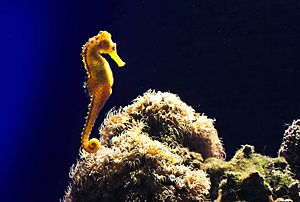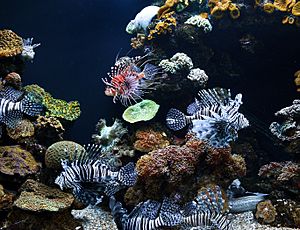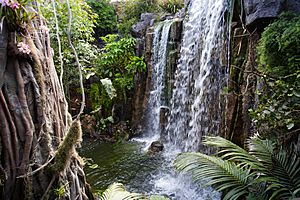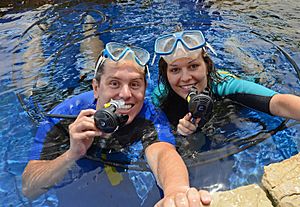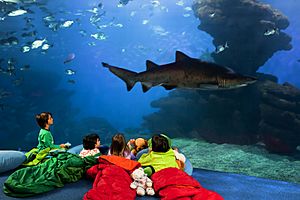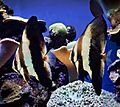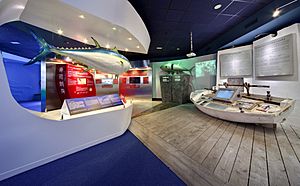Palma Aquarium facts for kids
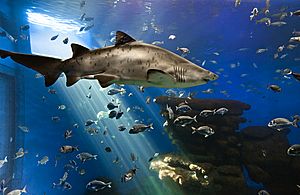
Palma Aquarium, the "Big Blue" tank
|
|
| Date opened | 2007 |
|---|---|
| Location | Manuela de los Herreros i Sorà, 21, 07610, Palma de Mallorca, Spain |
| Coordinates | 39°31′53″N 2°43′46″E / 39.53139°N 2.72944°E |
| No. of animals | 8,000 |
| No. of species | 700 |
| Volume of largest tank | 3,500,000 L (920,000 US gal) |
| Total volume of tanks | 5,000,000 L (1,300,000 US gal) |
| Major exhibits | 55 |
| Website | http://www.palmaaquarium.com/eng/ |
Palma Aquarium is a super cool aquarium and park that first opened in 2007 in Palma, Mallorca, Spain. It's owned by a company called Coral World International.
The aquarium is only about 500 meters (1,640 feet) from Playa de Palma beach. Inside, you'll find 55 tanks with over 700 different kinds of sea creatures! They come from the Mediterranean Sea and the Indian, Atlantic, and Pacific Oceans. One of its most amazing tanks is called "Big Blue." It's 8.5 meters (28 feet) deep, making it the deepest shark tank in all of Europe! It also has the biggest collection of real, living coral in Europe.
Palma Aquarium has won awards like "Best Business Initiative in the Balearics 2007" and the "2007 Accessibility Prize." The aquarium also organizes fun activities focused on the environment. They take part in important campaigns to protect and save marine life.
More than 400,000 people visit Palma Aquarium every year. That's over 1,000 visitors every single day! About half of the visitors are from Spain, and the rest are mostly from other parts of Europe. When you visit, it feels like you're taking a journey through the world's amazing seas and oceans.
Contents
- Exploring the Mediterranean Sea
- Discovering Tropical Seas
- Relaxing in the Mediterranean Gardens
- Exploring The Jungle
- The Amazing Big Blue
- The Mesmerizing Jellyfish Tank
- Fun Activities at Palma Aquarium
- Marine Species at Palma Aquarium
- Gallery of Tropical Fish Photos
- Research and Conservation Efforts
- Aquarium Facilities
- See also
Exploring the Mediterranean Sea
Your journey at Palma Aquarium starts in the Mediterranean Sea. Here, you'll see all sorts of marine animals and plants. Look out for colorful starfish, big lobsters, and even scorpion fish. You might also spot wrasses, groupers, and tiny shrimps.
There are also crabs, eels, rays, and cute seahorses. Don't miss the clever octopuses and long conger eels. You'll also see beautiful algae and coral. The best part? In the Touch Pools, you can gently touch some of these animals, like the starfish!
Discovering Tropical Seas
This section has 25 aquariums filled with animals from the warm, tropical parts of the Indian Ocean, Atlantic Ocean, and Pacific Ocean. Get ready to see amazing creatures like the spiky fire fish, the famous clown fish, and the colorful surgeon fish. You might even spot a blacktip reef shark swimming by!
The coral in Palma Aquarium's tropical tanks is truly special. It includes different types like gorgonians, mushroom coral, and honeycomb coral. You'll also see various anemones and tropical sponges. What makes this aquarium unique is that almost all the coral in its tanks is real and alive! Palma Aquarium is also one of the few places in Europe that grows its own new coral colonies.
Relaxing in the Mediterranean Gardens
Outside, you'll find a lovely garden area. It mixes Mediterranean plants with tanks full of turtles, bright koi fish, and gilthead bream. You can also see stingrays gliding through the water. This area has a cafeteria where you can grab a snack. There's also a fun children’s play area with a cool "pirate ship"! In the summer, the park has daily entertainment for kids, including face-painting, water fights, and exciting shows.
Exploring The Jungle
The Jungle area is designed to feel just like a real tropical rainforest. It's actually the largest roof-top garden in Spain, and one of the biggest in Europe! A waterfall and special mist machines create a humid atmosphere. This makes it the perfect microclimate for the Amazonian plants that grow there.
The Amazing Big Blue
The Big Blue is the deepest shark tank in Europe! It's a massive 8.5 meters (28 feet) deep, 33 meters (108 feet) long, and 25 meters (82 feet) wide. This huge tank holds 3.5 million liters (924,600 US gallons) of saltwater.
Inside, you'll find six sand tiger sharks, five sandbar sharks, and over 1,000 other fish! Visitors can walk through a clear tunnel that goes right through the middle of the tank. Imagine sharks and rays swimming all around and even over your head!
The Mesmerizing Jellyfish Tank
The Jellyfish tank is a tall, cylinder-shaped aquarium. It's home to about fifty jellyfish, most of which are the common Mediterranean species called Aurelia aurita. Watching them float and pulse is truly mesmerizing!
Fun Activities at Palma Aquarium
Palma Aquarium offers many exciting activities:
- Dive with the Sharks: This activity lets both adults and children get up close with sharks!
- Underwater: During the summer, visitors over eight years old can actually swim in the stingray tank in the Mediterranean Gardens.
- Shark Sleepover: Children aged 6 to 16 can spend the night camping right in front of the Big Blue shark tank. What an adventure!
- Birthdays: You can celebrate your birthday at the park with fun pirate-themed parties.
Marine Species at Palma Aquarium
Palma Aquarium is home to over 700 different species! These amazing creatures come from the Mediterranean Sea, and the Indian, Atlantic, and Pacific Oceans.
From the Mediterranean Sea:
- Asteroidea (Common starfish)
- Palinurus elephas (Spiny lobsters)
- Scyllarides latus (Mediterranean slipper lobster)
- Trachinus draco (Greater weaver)
- Symphodus tinca (East Atlantic peacock wrasse)
- Epinephelus marginatus (Dusky Grouper)
- Caridea (Caridean shrimp)
- Muraena helena (Mediterranean moray eel)
- Rajiformes (Rays)
- Hippocampus species (Seahorse)
- Octopoda (Octopus)
- Conger conger (European conger)
- Actiniaria (Sea anemones)
- Pennatulacea (Sea pen)
- Corallium rubrum (Red coral)
- Caulerpa species (Caulerpa)
- Ascidiacea (Sea squirts)
- Holothuria species (Sea cucumber)
- Paracentrotus lividus (Sea urchin)
From Tropical Seas:
- Alcyonacea (Gorgonia)
- Fungia scutaria (Mushroom coral)
- Pseudanthias squamipinnis (Anthias tropical)
- Labridae (Wrasse)
- Amphiprion ocellaris (Clownfish)
- Pterois antennata (Broadbarred firefish)
- Zebrasoma flavescens (Surgeon fish)
- Ensis species (Razor clam)
- Syngnathinae (Pipefish)
- Synchiropus splendidus (Mandarinfish)
- Ostracion cubicus (Box fish)
- Gobio (Gudgeon)
- Porifera (Sponges)
- Carcharhinus melanopterus (Blacktip reef shark)
- Hypostomus species (Red devil cichlid)
- Serrasalmus species (Piranha)
From the Mediterranean Gardens:
- Eretmochelys imbricata (Hawksbill turtle)
- Cyprinus carpio (Koi fish)
From the Big Blue Tank:
- Rhinobatidae (Guitarfish)
- Carcharias taurus (Sand Tiger Shark)
- Carcharhinus plumbeus (Sandbar shark)
- Dicentrarchus labrax (European seabass)
- Sparus aurata (Gilt-head bream)
- Seriola dumerili (Greater amberjack)
- Mugil (Mullet)
- Myliobatis aquila (Eagle ray)
- Dasyatis pastinaca (Common stingray)
- Dentex dentex (Common dentex)
- Diplodus vulgaris (Sparidae)
- Coris julis (Mediterranean rainbow wrasse)
- Centracanthidae (Picarel)
- Chromis chromis (Chromis)
From the Jellyfish Tank:
- Aurelia aurita (Jellyfish)
Gallery of Tropical Fish Photos
Research and Conservation Efforts
Palma Aquarium is involved in many important research programs. They work on growing and restoring coral reefs in special controlled environments. This helps protect these vital underwater habitats.
The park also runs a big campaign to save the Mediterranean Blue Fin Tuna. This amazing fish is in danger of disappearing because too many are being caught. The aquarium even has an exhibit to teach visitors about this problem.
Palma Aquarium also helps protect a special plant called Limonium barceloi. This plant only grows in the southern Balearics. Sometimes, the aquarium helps rescue and care for marine animals that are hurt or sick. They work with universities and research centers to help animal populations that are shrinking or in danger of extinction.
Aquarium Facilities
The indoor path at Palma Aquarium is 900 meters (2,953 feet) long. The outdoor area is huge, covering 41,825 square meters (450,200 square feet). There are 55 tanks in total, holding 5 million liters (1.3 million US gallons) of sea water. You can see about 8,000 marine animals from around 700 different species!
The aquarium is open every day of the year. There's a gift shop where you can find souvenirs, a large public car park, and an event room that can hold up to 350 people.
See also
 In Spanish: Palma Aquarium para niños
In Spanish: Palma Aquarium para niños


